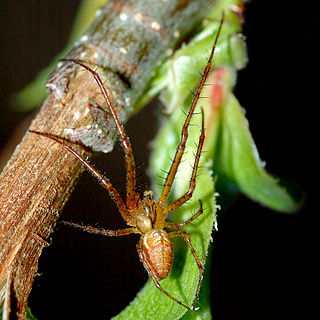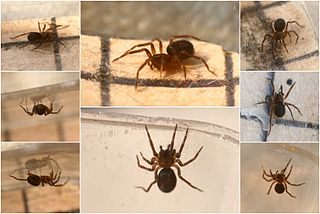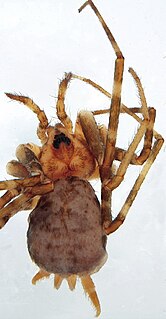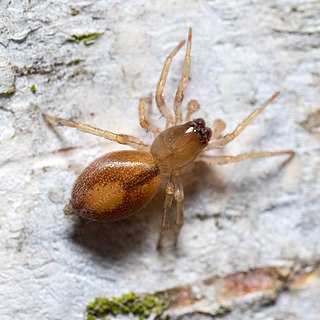
Latrodectus is a broadly distributed genus of spiders with several species that are commonly known as the true widows. This group is composed of those often loosely called black widow spiders, brown widow spiders, and similar spiders. However, such general "common names" are of limited use, as the diversity of species is much greater. A member of the family Theridiidae, this genus contains 34 species, which include several North American "black widows". Besides these, North America also has the red widow Latrodectus bishopi and the brown widow Latrodectus geometricus, which, in addition to North America, has a much wider geographic distribution. Elsewhere, others include the European black widow, the Australian redback black widow and the closely related New Zealand katipō, several different species in Southern Africa that can be called Button spiders, and the South American black-widow spiders. Species vary widely in size. In most cases, the females are dark-coloured, but some may have lighter or even reddish bodies. Many can have red, white or brown markings on the upper-side (dorsal) of the abdomen. Some can be readily identifiable by reddish markings on the central underside (ventral) abdomen, which are often hourglass-shaped.

Spitting spiders (Scytodidae) is a family of araneomorph spiders first described by John Blackwall in 1864. It contains over 250 species in five genera, of which Scytodes is the best-known.

The spider genus Steatoda, in the family Theridiidae, includes about 120 recognized species, distributed around the world. One common name is cupboard spider, for many species build their webs in dark, sheltered, undisturbed places around the house or garden, in sheds and garages, under garden furniture, compost bins, and the like. Signs of the cupboard spider include small white spots of spider droppings, like small splashes of paint, on the floor underneath the web.

Cynapes is a genus of African jumping spiders that was first described by Eugène Louis Simon in 1900.
Goleba is a genus of African jumping spiders that was first described by F. R. Wanless in 1980.

Peucetia is a genus of lynx spiders that is found worldwide.

Stegodyphus is a genus of velvet spiders that was first described by Eugène Simon in 1873. They are distributed from Africa to Europe and Asia, with one species found in Brazil. The name is derived from Ancient Greek στέγω, meaning "covered".

Metellina is a genus of tetragnathid spiders that occurs mostly in Eurasia, with two species found in North America. M. segmentata was introduced to Canada.

Microlinyphia is a genus of dwarf spiders that was first described by U. Gerhardt in 1928.

Savignia is a genus of sheet weavers that was first described by John Blackwall in 1833. The name honors the French naturalist Marie Jules César Savigny.

Caerostris, sometimes called bark spiders, is a genus of orb-weaver spiders first described by Tamerlan Thorell in 1868. Most species are found in south eastern Africa and neighboring Madagascar.

Paraplectana is a genus of Asian and African orb-weaver spiders first described by F. de Brito Capello in 1867.

Iberina is a genus of dwarf sheet spiders that was first described by Eugène Simon in 1881.
Afroneutria is a genus of spiders in the family Ctenidae. It was first described in 2015 by Polotow & Jocqué. As of 2017, it contains 6 species, all African.

Hersiliola is a genus of tree trunk spiders that was first described by Tamerlan Thorell in 1870.

Bolyphantes is a genus of dwarf spiders that was first described by Carl Ludwig Koch in 1837.
Prinerigone is a genus of sheet weavers that was first described by Alfred Frank Millidge in 1988.
Hersiliola versicolor is a species of spiders of the family Hersiliidae that lives in Cape Verde. It was first described by John Blackwall in 1865 as Hersilia versicolor. The females have a total length of 3.75-4.58 mm.

Porrhoclubiona is a genus of sac spiders that was first described as a subgenus of Clubiona by H. Lohmander in 1944. Clubiona is a polyphyletic group that has been divided and reorganized many times, and whether this genus is a synonym of Clubiona or an independent genus is still under debate.

Trichonephila is a genus of orb-weaver spiders that was first described by Friedrich Dahl in 1911, as a subgenus of Nephila. Trichonephila was elevated to the level of genus by Kuntner et al. in 2019. The genus Trichonephila belongs to the Araneidae family, also known as the orb weavers. The family Araneidae belongs within the superfamily of Araneoidea, comprised of 18 families in it. Araneidae family members can be identified by looking for three-clawed spiders that have eight eyes spanned across two sets which form a trapezoid shape, on webs with a sticky glue like feeling. The very diverse Araneidae family is most famously known for their elaborate webs they spin, which are webs made of concentric circles with spokes extending out from the center. In few species of the spiders, you can find a zigzag shape going down the center of the web. Identifying the species of these spiders is not easy with the eye alone, it breaks down into phylogenomic variations between their species best observed under a microscope. The genus Trichonephila, like all other spider species in the world, are all predators. Not a single spider exists that is solely a herbivore or a detrivore.















